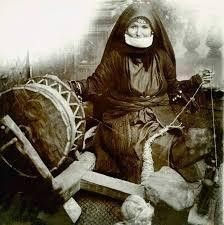Armenian Spinning
The fibers spun are cotton, silk, and linen for fabrics.[1] They started by importing silk from China, but eventually had their own sericulture.[2] They use wool for the rugs they are famous for, often from local villages.[3] Armenian lace is also sought after (Venetian lace is thought to have come from Armenian lace)[4] and required very finely spun thread.
An Armenian woman spinning on a weird drum wheel.[5]I love the way this wheel looks. I wonder how heavy it is?
Women and boys with cotton and wheels. The poster posits that they might be refugees and these might be supplies so that they can start a new life. It’s wonderful what spinning can do![6]


References
[1] “Arts of Armenia,” Textiles - Armenian Studies Program, accessed June 16, 2025, https://cah.fresnostate.edu/armenianstudies/resources/artsofarmenia/textiles.html.
[2] Molly Hutto, “A Single Thread, Part One: Textiles in the Near East,” Near East Relief Historical Society, April 6, 2018, https://neareastmuseum.com/2018/02/16/single-thread-part-one-textiles-near-east/.
[3] Kyle Khandikian, “Rugs of Resilience: Unraveling the Symbolism of Armenia’s Weaving Traditions,” Ajam Media Collective, August 5, 2024, https://ajammc.com/2024/08/04/armenian-rugs-of-resilience/.
[4] “Arts of Armenia.” Textiles - Armenian Studies Program. Accessed June 16, 2025. https://cah.fresnostate.edu/armenianstudies/resources/artsofarmenia/textiles.html.
[5] An Armenian Woman Spinning Thread, April 4, 2023, photograph, Instagram, April 4, 2023, https://www.instagram.com/p/CqnVshAgzj8/.
[6] Armenian Women And Boys With Spinning Wheels And Cotton, 1915, photograph, Posterazzi, 1915, https://www.posterazzi.com/armenian-women-and-boys-with-spinning-wheels-and-cotton-ca-1915-21-this-is-possibly-a-refugee-family-receiving-tools-to-make-a-living-in-yerevan-history-item-varevchisl035ec277/.